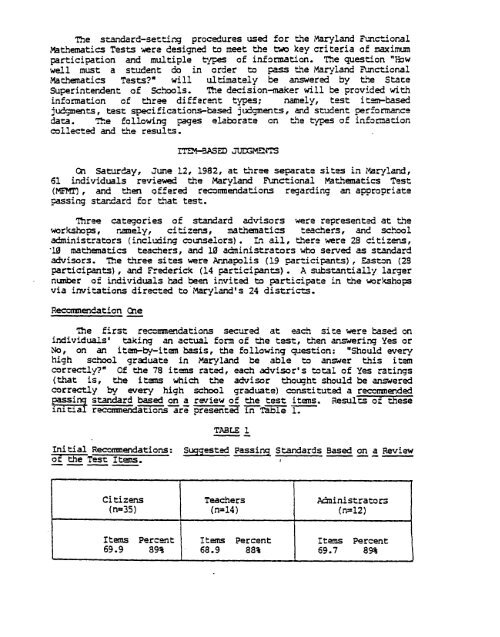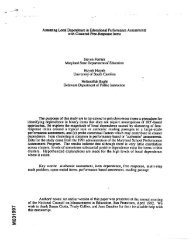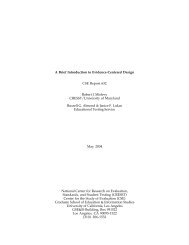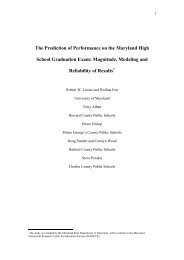Setting a Passing Standard for the Maryland Functional Tests.
Setting a Passing Standard for the Maryland Functional Tests.
Setting a Passing Standard for the Maryland Functional Tests.
Create successful ePaper yourself
Turn your PDF publications into a flip-book with our unique Google optimized e-Paper software.
The standard-setting procedures used <strong>for</strong> <strong>the</strong> <strong>Maryland</strong> <strong>Functional</strong><br />
Ma<strong>the</strong>matics <strong>Tests</strong> were designed ~ meet <strong>the</strong> ~o key criteria of maxim~<br />
participation and mul~/ple ~fpes of in<strong>for</strong>mation. The question "How<br />
well must a student do in order to pass <strong>the</strong> Mmryland <strong>Functional</strong><br />
Ma<strong>the</strong>mat/cs <strong>Tests</strong>?" will ultimately be answered by ~_he State<br />
Superintendent of Schools. The decision-maker will be provided wi~h<br />
in<strong>for</strong>mation of three different types; namely, test i ~an-based<br />
judgments, test specifications-based judgments, and student per<strong>for</strong>mance<br />
dana. The following pages elabora=e on <strong>the</strong> types of in<strong>for</strong>mer.ion<br />
collected and <strong>the</strong> results.<br />
~-T~M-KASED ~<br />
u-JEC, MEVI~<br />
On Saturday, June 12, 1982, at three separate sites in <strong>Maryland</strong>,<br />
61 individuals reviewed <strong>the</strong> <strong>Maryland</strong> <strong>Functional</strong> Mmt~hematics Test<br />
(MFMT] , and <strong>the</strong>n offered recommendations regarding an appropriate<br />
~uassing star~ard <strong>for</strong> ~.hat test.<br />
Three categories of standard advisors were represented at t~he<br />
workshops, r~mely, ci tizens, ma<strong>the</strong>matics teachers, and school<br />
administrators (including coumselors). Ln all, ~here were 28 citizens,<br />
"19 mat.hema~/cs teachers, and !Z administrators who served as standard<br />
advisors. The three sites were Annapolis (19 participants), Easrmn (28<br />
par~:icipants), and Frederick (14 participants). A substantially larger<br />
number of individuals ~d been invited to participate in <strong>the</strong> workshops<br />
via invitations directed to<strong>Maryland</strong>'s 24 dis~ric'~.<br />
Reccn'~nendation Cne<br />
~he first recon~nemdations secured at each site were based on<br />
individuals' taking an actual <strong>for</strong>m of <strong>the</strong> test, <strong>the</strong>n answering Yes or<br />
No, on an item-by-i~.am basis, <strong>the</strong> following question: "Should every<br />
high school graduate in <strong>Maryland</strong> be able to answer this item<br />
correctly?" Of <strong>the</strong> 78 items rated, each advisor's total of Yes ratings<br />
(that is, <strong>the</strong> items which <strong>the</strong> advisor t~hought should be answered<br />
correctly by every high school graduate) constituted a reccn~nended<br />
standard based on a review of <strong>the</strong> tes~ items. Resul~s of <strong>the</strong>se<br />
initial r--~endatio~-~r~ presen~e~[ ~-n "TaD--~ ~.<br />
TABLE I<br />
Initial Reco~endations:<br />
of <strong>the</strong> Tesu Items.<br />
Suggested Passin~ <strong>Standard</strong>s Based on a Review<br />
Citizens<br />
(n=35)<br />
Teachers<br />
(n=14)<br />
Aduinistrato rs<br />
(n=12)<br />
Items<br />
69.9<br />
Percent<br />
89%<br />
items Percent<br />
68.9 88%<br />
Itzms Percent<br />
69.7 89%






